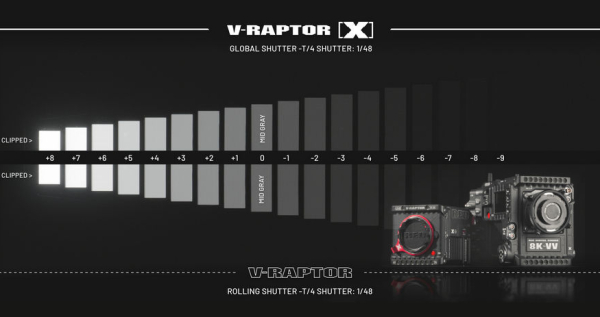Extended Highlights is a beta function in the  new RED cameras V-RAPTOR[X] and V-RAPTOR XL[X]. This is a dynamic extension that allows additional drawing in the highlights that are normally already clipped.
new RED cameras V-RAPTOR[X] and V-RAPTOR XL[X]. This is a dynamic extension that allows additional drawing in the highlights that are normally already clipped.
There are various technical approaches for this: A frequently chosen approach is  Highlight Recovery, which attempts to interpolate or reconstruct the missing information of the clipped scythe from unclipped scythes. As this can never be one hundred percent correct, this option usually remains optional in RAW development.
Highlight Recovery, which attempts to interpolate or reconstruct the missing information of the clipped scythe from unclipped scythes. As this can never be one hundred percent correct, this option usually remains optional in RAW development.
Another option is double exposure with different exposure times. Canon uses this method with some sensors, as does  Panasonic with the Dynamic Boost of its GH6 and G9II.
Panasonic with the Dynamic Boost of its GH6 and G9II.
Here, each frame is exposed twice: Once with the desired exposure time and once with a significantly shorter exposure time. The overexposed sensel can then be restored from the significantly shorter exposure.

RED V-RAPTOR[X] and XL - Extended dynamic range through double exposure
However, the resulting time offset between the two exposures can be a problem. If the pixels of the images are not congruent, a correct adjustment is not easily possible.
Such tricks of dynamic range expansion through double exposure can usually be recognized by the fact that the maximum frame rates of the sensor are halved in this mode. And it is precisely this behavior that RED now describes in its blog about the new cameras:
"When the Extended Highlights option is enabled, the maximum frame rate per format is reduced by half. In addition, the data rates are doubled and in some cases the available R3D quality can be reduced. "The in-camera ISO selection is also limited to ISO 1600.".
And because double exposures can lead to motion artifacts in fast movement, RED recommends only using the function if there is no other way to avoid clipping in the image. There are also explicit recommendations as to when it is better not to use the function:
"Extended Highlights are not recommended when filming with LED lighting or in any other environment where synchronization is critical. It is also not recommended to use Extended Highlights in handheld scenes with a lot of movement. (...)
It is possible that there will be additional motion blur or "ghosting" in the image if there is excessive motion in the area of reconstructed highlight detail."
But there is also good news: The offsetting only takes place in post-production and the extended highlights can also be subsequently deactivated in post-production - so it is a non-destructive process. This means that there is little reason not to leave the function activated. However, this doubles the data rate of the recording and you are naturally restricted in the selection of maximum frame rates.
Whether  RED has measured its 17+ f-stops of the new cameras with the Extended Highlights option activated remains to be seen. In any case, it is highly likely.
RED has measured its 17+ f-stops of the new cameras with the Extended Highlights option activated remains to be seen. In any case, it is highly likely.

